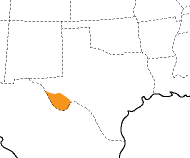Reticulated Banded Gecko
Scientific Name: Coleonyx reticulatus / Common Names: Reticulated Banded Gecko
|
This is a "banded gecko" that often loses its bands as it grows, leaving only scattered dark brown spots on a pinkish tan body. Like other banded geckos, Reticulated Geckos lack toepads and have moveable eyelids. They have enlarged wart-like tubercles or raised scales scattered among the tiny granular scales on the back. Juvenile Reticulated Geckos resemble juvenile Texas Banded Geckos, with dark brown cross bands separated by narrow light bands, but are larger, hatching at about 3.1 in. (8 cm) TL. They can reach 5.5 - 6.75 in. (14 - 17.2 cm) TL, up to a third larger than Texas Banded Geckos.
Habitat and Range This species is known only from Brewster and Presidio counties in the Big Bend region of Texas, with a few scattered records in northern Mexico. It prefers cliff crevices and rocky areas for diurnal retreats. Habits Heavy rains bring these geckos out of hiding. Like other banded geckos, they are terrestrial and nocturnal, most often seen on roads at night. They avoid the heat of the day by hiding under logs, debris or in moist rock crevices. They feed on arthropods and store food in their fleshy tails. Their voice is a faint squeak. Banded gecko tails break off easily as a predator defense and are quickly regrown. The regenerated tail is shorter than the original and has different color pattern and scales. Females are reported to lay clutches of two eggs. Similar Species The closely related Texas Banded Gecko is smaller, more distinctly banded and lacks enlarged tubercles on the back. The Mediterranean Gecko, known from south-central and southeastern Texas, has large toepads and lacks moveable eyelids. Conservation & Other Threats Mostly due to its tiny range, it has been listed as a threatened species by the state of Texas. A large portion of their range falls within Big Bend National Park, but collection by unscrupulous hobbyists is a threat. This species profile relies heavily on: Conant et al. 1998; Garrett & Barker 1987 |
Size:
Habitat:
Active During:
Diet:
Color/Pattern:
Location:
|









